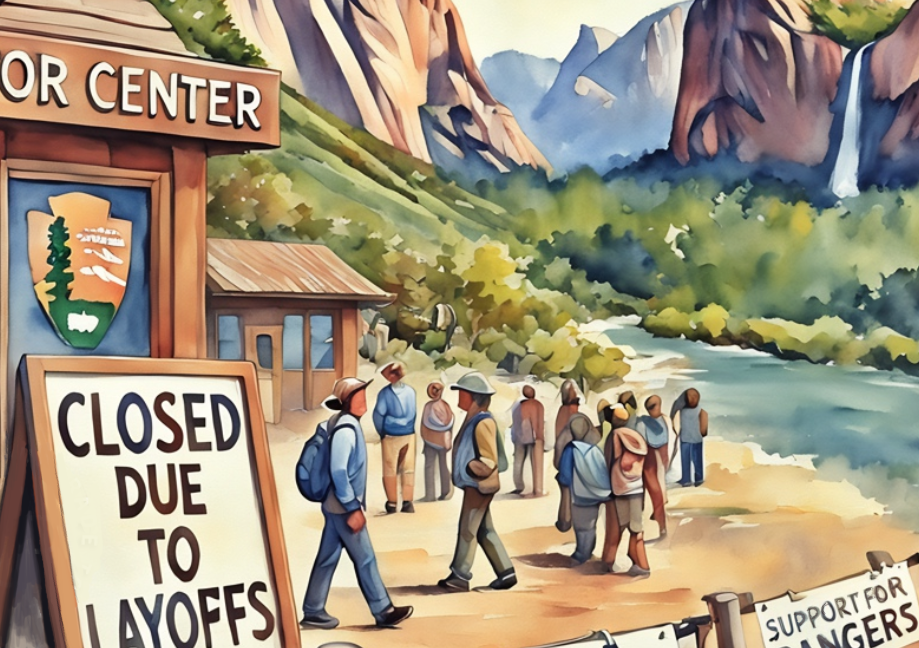
Who’s Protecting Our National Parks?
When someone asks me for a fun fact about myself, I never have to think twice. My answer? “I’ve been to 22 national parks!”
My family and I love national parks. From the scorching sand flats of Death Valley to the breathtaking views of the Smoky Mountains, I’ve been lucky enough to witness the wonders of the environment up close. I’ve stood beneath trees a hundred times my height in Sequoia National Park, hiked through red rock formations in Antelope Valley, and watched the most beautiful sunsets paint the sky in the Smoky Mountains. I’ve seen moose cross the road in Yosemite, smelled the rotten-egg sulfur of the rainbow pools, and trekked down to Crater Lake to watch its crystal-clear waters shimmer under the sun.
Our first stop at any national park? The entrance sign, so we can snap a selfie, of course. But right after that, we head straight to the visitor center. We grab a map, read the exhibits, and most importantly, talk to the rangers. They help us plan the best routes for our time, tell us which spots to prioritize, and share fascinating facts about the park. Their passion for conservation shines through in every conversation. They genuinely want visitors to experience the beauty of these parks while respecting and preserving them.
But lately, there’s been a problem. Thousands of these workers–rangers, scientists, maintenance staff–have been laid off, and the future of our national parks is uncertain.
A System in Crisis
The National Park Service (NPS) oversees 63 national parks and 423 national sites across the U.S., protecting some of the most stunning landscapes and historic landmarks in the country. These parks stretch across nearly 3,000 miles, welcoming over 297 million visitors each year. They not only serve as places of adventure, where people hike, camp, and explore, but also as vital ecosystems where wildlife can thrive.
However, in recent months, the NPS has faced significant staffing challenges due to widespread layoffs and budget cuts. These cuts threaten the very integrity of our national parks, making it increasingly difficult for them to operate and fulfill their mission of conservation.
National park workers do so much more than just hand out maps at visitor centers. They are the backbone of the parks, responsible for:
- Conservation & Resource Management: Protecting plants, animals, and ecosystems.
- Cultural Preservation: Studying and interpreting historical sites and artifacts.
- Visitor Safety & Emergency Response: Rescuing lost hikers, managing wildfires, and responding to medical emergencies.
- Infrastructure & Maintenance: Repairing trails, maintaining restrooms, and keeping parks clean.
- Education & Community Engagement: Leading guided tours, answering questions, and fostering a love for nature.
Yet, in February, the Department of Government Efficiency (DOGE) initiated massive budget cuts, resulting in over 1,000 employees being laid off, including rangers, maintenance crews, and scientists. With fewer staff, crucial functions like wildfire response, land use planning, and conservation efforts are now at risk.
The Fallout
In response, protests erupted across the country. Demonstrations took place at Yosemite National Park, Muir Woods National Monument, and Haleakalā National Park, where over 650 rangers and supporters rallied against the layoffs. Protesters emphasized not only the loss of jobs but also the broader impact on national parks, highlighting their cultural, historical, and economic value.
The effects of these cuts are already visible. Arches National Park stopped issuing permits for its renowned Fiery Furnace hikes due to staffing shortages. The route winds through a maze of narrow sandstone canyons and requires physical agility and careful navigation, making ranger guidance or permits essential. Many visitor centers, once bustling with excited tourists eager to plan their adventures, now stand empty. Trails are going unmaintained. Emergency response times are increasing. The parks are struggling.
Legal challenges and public pressure have led to some reinstatements: about 400 of the 1,000 laid-off employees have been rehired so far. But that still leaves hundreds of workers in limbo, and the threat of further cuts looms. The National Parks Conservation Association (NPCA) has criticized the selective rehiring process, arguing that without full staffing, the parks cannot function effectively.
Why This Matters
The fate of our national parks is more than just an environmental issue: it’s a national identity issue. These parks are some of the most beautiful and treasured parts of the U.S., offering not just stunning landscapes but also history, culture, and a connection to the natural world. Without the workers who protect and maintain them, they simply cannot survive.
The situation is still unfolding, with ongoing protests, legal battles, and policy debates. But one thing is certain: our national parks need protecting. And that starts with ensuring the people who dedicate their lives to them aren’t left behind. Because the next time someone asks me for a fun fact, I don’t want to say: I used to visit national parks. I want to say, I still do.
Works Cited:
Fitzpatrick, Alex. “These National Parks Have Been Hit Hardest by Firings.” Axios, 5 Mar. 2025, www.axios.com/2025/03/05/national-park-federal-workers-layoffs-trump. Accessed 2 Apr. 2025.
Hebert, Olivia. “Judge Says National Park Service Must Reinstate All Fired Employees.” SFGATE, 13 Mar. 2025, www.sfgate.com/california-parks/article/judge-says-park-service-reinstate-fired-employees-20220040.php. Accessed 2 Apr. 2025.
Jackson, Katie. “Popular Hike in Arches National Park Closes Indefinitely amid Staffing Crisis – the Trek.” The Trek, 26 Mar. 2025, thetrek.co/popular-hike-in-arches-national-park-closes-indefinitely-amid-staffing-crisis/#:~:text=Recent%20developments%2C%20however%2C%20have%20thrust,consequence%20of%20these%20staffing%20shortfalls. Accessed 2 Apr. 2025.
“Park Ranger | U.S. Department of the Interior.” Doi.gov, 2025, careers.doi.gov/occupational-series/park-ranger. Accessed 2 Apr. 2025.
Treisman, Rachel. “National Parks Already Feel the Effects of Layoffs, Even before the Busy Season Starts.” NPR, 26 Feb. 2025, www.npr.org/2025/02/26/nx-s1-5307908/national-parks-layoffs-visitors-disruptions. Accessed 2 Apr. 2025.
“Work for Us (U.S. National Park Service).” Nps.gov, 2025, www.nps.gov/aboutus/workwithus.htm. Accessed 2 Apr. 2025.
The views and opinions expressed are those of the authors and do not necessarily reflect nor represent the Earth Chronicles and its editorial board.





Comments are closed.